香港中文大学:《Probability and Statistics for Engineers》课程教学资源(辅导材料)Tutorial 11:Limit Theorems
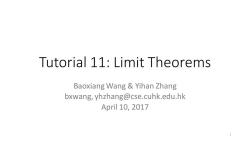
Tutorial 11:Limit Theorems Baoxiang Wang Yihan Zhang bxwang,yhzhang@cse.cuhk.edu.hk April 10,2017
Tutorial 11: Limit Theorems Baoxiang Wang & Yihan Zhang bxwang, yhzhang@cse.cuhk.edu.hk April 10, 2017 1
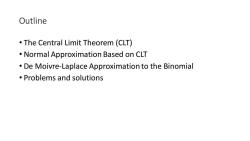
Outline The Central Limit Theorem(CLT) Normal Approximation Based on CLT De Moivre-Laplace Approximation to the Binomial Problems and solutions
Outline • The Central Limit Theorem (CLT) • Normal Approximation Based on CLT • De Moivre-Laplace Approximation to the Binomial • Problems and solutions
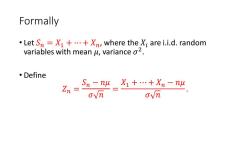
Formally Let Sn=X1+...+Xn,where the Xi are i.i.d.random variables with mean u,variance o2. 。Define Sn-nw_X1+…+Xn-nw ovn
Formally • Let 𝑆𝑛 = 𝑋1 + ⋯ + 𝑋𝑛, where the 𝑋𝑖 are i.i.d. random variables with mean 𝜇, variance 𝜎 2 . • Define 𝑍𝑛 = 𝑆𝑛 − 𝑛𝜇 𝜎 𝑛 = 𝑋1 + ⋯ + 𝑋𝑛 − 𝑛𝜇 𝜎 𝑛
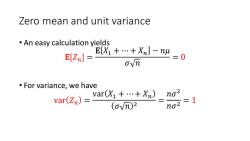
Zero mean and unit variance An easy calculation yields E[X1+…+XnJ-n E[Zn] ovn 2二0 。For variance,we have var(X1+…+Xn) no2 var(Zn)= (ovn)2 n21
Zero mean and unit variance • An easy calculation yields E[𝑍𝑛] = E 𝑋1 + ⋯ + 𝑋𝑛 − 𝑛𝜇 𝜎 𝑛 = 0 • For variance, we have var 𝑍𝑛 = var 𝑋1 + ⋯ + 𝑋𝑛 𝜎 𝑛 2 = 𝑛𝜎 2 𝑛𝜎 2 = 1
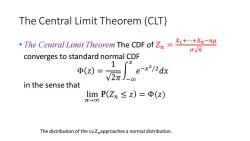
The Central Limit Theorem(CLT) .The Central Limit Theorem The CDF ofn=n o√m converges to standard normal CDF in the sense that limP(Zn≤z)=Φ(z) n→0∞ The distribution of the r.v.Znapproaches a normal distribution
The Central Limit Theorem (CLT) • The Central Limit Theorem The CDF of 𝑍𝑛 = 𝑋1+⋯+𝑋𝑛−𝑛𝜇 𝜎 𝑛 converges to standard normal CDF Φ 𝑧 = 1 2𝜋 න −∞ 𝑧 𝑒 −𝑥 2/2𝑑𝑥 in the sense that lim 𝑛→∞ P 𝑍𝑛 ≤ 𝑧 = Φ(𝑧) The distribution of the r.v.𝑍𝑛approaches a normal distribution
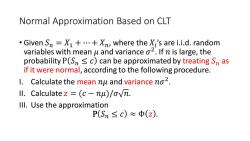
Normal Approximation Based on CLT Given Sn=X1+...+Xn,where the Xi's are i.i.d.random variables with mean u and variance o2.If n is large,the probability P(Sn<c)can be approximated by treating Sn as if it were normal,according to the following procedure. . Calculate the mean nu and variance no2. ll.Calculatez (c-nu)/ovn. lll.Use the approximation P(Sn≤c)≈Φ(z):
Normal Approximation Based on CLT • Given 𝑆𝑛 = 𝑋1 + ⋯ + 𝑋𝑛, where the 𝑋𝑖 ’s are i.i.d. random variables with mean 𝜇 and variance 𝜎 2 . If 𝑛 is large, the probability P 𝑆𝑛 ≤ 𝑐 can be approximated by treating 𝑆𝑛 as if it were normal, according to the following procedure. I. Calculate the mean 𝑛𝜇 and variance 𝑛𝜎2 . II. Calculate 𝑧 = (𝑐 − 𝑛𝜇)/𝜎 𝑛. III. Use the approximation P 𝑆𝑛 ≤ 𝑐 ≈ Φ 𝑧
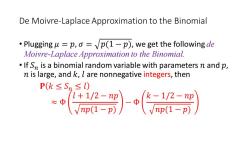
De Moivre-Laplace Approximation to the Binomial Plugging u =p,o =p(1-p),we get the following de Moivre-Laplace Approximation to the Binomial. If Sn is a binomial random variable with parameters n and p, n is large,and k,l are nonnegative integers,then P(k≤Sn≤l) ≈中 》-3》 l+1/2-np
De Moivre-Laplace Approximation to the Binomial • Plugging 𝜇 = 𝑝, 𝜎 = 𝑝(1 − 𝑝), we get the following de Moivre-Laplace Approximation to the Binomial. • If 𝑆𝑛 is a binomial random variable with parameters 𝑛 and 𝑝, 𝑛 is large, and 𝑘, 𝑙 are nonnegative integers, then 𝐏 𝑘 ≤ 𝑆𝑛 ≤ 𝑙 ≈ Φ 𝑙 + 1/2 − 𝑛𝑝 𝑛𝑝(1 − 𝑝) − Φ 𝑘 − 1/2 − 𝑛𝑝 𝑛𝑝(1 − 𝑝)
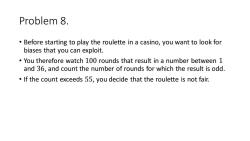
Problem 8. Before starting to play the roulette in a casino,you want to look for biases that you can exploit. You therefore watch 100 rounds that result in a number between 1 and 36,and count the number of rounds for which the result is odd. If the count exceeds 55,you decide that the roulette is not fair
Problem 8. • Before starting to play the roulette in a casino, you want to look for biases that you can exploit. • You therefore watch 100 rounds that result in a number between 1 and 36, and count the number of rounds for which the result is odd. • If the count exceeds 55, you decide that the roulette is not fair
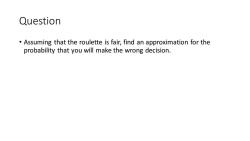
Question Assuming that the roulette is fair,find an approximation for the probability that you will make the wrong decision
Question • Assuming that the roulette is fair, find an approximation for the probability that you will make the wrong decision
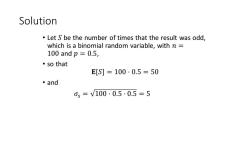
Solution Let S be the number of times that the result was odd, which is a binomial random variable,with n 100andp=0.5, ·so that E[S]=100·0.5=50 。and 0s=V100·0.5·0.5=5
Solution • Let 𝑆 be the number of times that the result was odd, which is a binomial random variable, with 𝑛 = 100 and 𝑝 = 0.5, • so that 𝐄[𝑆] = 100 · 0.5 = 50 • and 𝜎𝑠 = 100 · 0.5 · 0.5 = 5
按次数下载不扣除下载券;
注册用户24小时内重复下载只扣除一次;
顺序:VIP每日次数-->可用次数-->下载券;
- 香港中文大学:《Probability and Statistics for Engineers》课程教学资源(辅导材料)Tutorial 9:Further Topics on Random Variables 2.pptx
- 香港中文大学:《Probability and Statistics for Engineers》课程教学资源(辅导材料)Tutorial 11:Limit Theorems.pdf
- 香港中文大学:《Probability and Statistics for Engineers》课程教学资源(辅导材料)Tutorial 8:Further Topics on Random Variables 1.pdf
- 香港中文大学:《Probability and Statistics for Engineers》课程教学资源(辅导材料)Tutorial 10:Limit Theorems.pptx
- 香港中文大学:《Probability and Statistics for Engineers》课程教学资源(辅导材料)Tutorial 10:Limit Theorems.pdf
- 香港中文大学:《Probability and Statistics for Engineers》课程教学资源(辅导材料)Tutorial 7:General Random Variables 3.pptx
- 香港中文大学:《Probability and Statistics for Engineers》课程教学资源(辅导材料)Tutorial 7:General Random Variables 3.pdf
- 香港中文大学:《Probability and Statistics for Engineers》课程教学资源(辅导材料)Tutorial 6:General Random Variables 2.pptx
- 香港中文大学:《Probability and Statistics for Engineers》课程教学资源(辅导材料)Tutorial 6:General Random Variables 2.pdf
- 香港中文大学:《Probability and Statistics for Engineers》课程教学资源(辅导材料)Tutorial 5:General Random Variables 1.pptx
- 香港中文大学:《Probability and Statistics for Engineers》课程教学资源(辅导材料)Tutorial 5:General Random Variables 1.pdf
- 香港中文大学:《Probability and Statistics for Engineers》课程教学资源(辅导材料)Tutorial 4:Discrete Random Variables 2.pptx
- 香港中文大学:《Probability and Statistics for Engineers》课程教学资源(辅导材料)Tutorial 4:Discrete Random Variables 2.pdf
- 香港中文大学:《Probability and Statistics for Engineers》课程教学资源(辅导材料)Tutorial 3:Discrete Random Variables 1.pptx
- 香港中文大学:《Probability and Statistics for Engineers》课程教学资源(辅导材料)Tutorial 3:Discrete Random Variables 1.pdf
- 香港中文大学:《Probability and Statistics for Engineers》课程教学资源(辅导材料)Tutorial 2:Sample Space and Probability 2.pptx
- 香港中文大学:《Probability and Statistics for Engineers》课程教学资源(辅导材料)Tutorial 2:Sample Space and Probability 2.pdf
- 香港中文大学:《Probability and Statistics for Engineers》课程教学资源(辅导材料)Tutorial 1:Sample Space and Probability 1.pptx
- 香港中文大学:《Probability and Statistics for Engineers》课程教学资源(辅导材料)Tutorial 1:Sample Space and Probability 1.pdf
- 香港中文大学:《Probability and Statistics for Engineers》课程教学资源(课件讲稿)Classical Statistical Inference.pptx
- 香港中文大学:《Probability and Statistics for Engineers》课程教学资源(辅导材料)Tutorial 9:Further Topics on Random Variables 2.pdf
- 香港中文大学:《Probability and Statistics for Engineers》课程教学资源(辅导材料)Tutorial 8:Further Topics on Random Variables 1.pptx
- 香港中文大学:《Topics in Theoretical Computer Science》课程教学资源(PPT课件讲稿)Lecture 1 Review of basic concepts of algorithms and complexity, probability and tail bounds.pptx
- 香港中文大学:《Topics in Theoretical Computer Science》课程教学资源(PPT课件讲稿)Lecture 2 Linear program. Examples, Simplex algorithms, primal-dual, strong duality(and a physical interpretation), application to games.pptx
- 香港中文大学:《Topics in Theoretical Computer Science》课程教学资源(PPT课件讲稿)Lecture 3 Algorithms for data streams.pptx
- 香港中文大学:《Topics in Theoretical Computer Science》课程教学资源(PPT课件讲稿)Lecture 4 Approximation algorithms.pptx
- 香港中文大学:《Topics in Theoretical Computer Science》课程教学资源(PPT课件讲稿)Lecture 5 NP-Complete problems.pptx
- 香港中文大学:《Topics in Theoretical Computer Science》课程教学资源(PPT课件讲稿)Lecture 6 Algorithms for resource allocation.pptx
- 香港中文大学:《Topics in Theoretical Computer Science》课程教学资源(PPT课件讲稿)Lecture 8 Mechanism design.pptx
- 香港中文大学:《Topics in Theoretical Computer Science》课程教学资源(PPT课件讲稿)Lecture 9 Online algorithm.pptx
- 香港中文大学:《Topics in Theoretical Computer Science》课程教学资源(PPT课件讲稿)Lecture 10 Online learning. Expert problem.pptx
- 香港中文大学:《Topics in Theoretical Computer Science》课程教学资源(PPT课件讲稿)Lecture 11 Influence maximization on social network.pptx
- 香港中文大学:《Topics in Theoretical Computer Science》课程教学资源(PPT课件讲稿)Lecture 12 Quantum computing. Quantum algorithms, BQP, quantum non-locality, quantum games.pptx
- 香港中文大学:《Quantum Computing》课程教学资源(课件讲稿)Lecture 1 Basics.docx
- 香港中文大学:《Quantum Computing》课程教学资源(课件讲稿)Lecture 2 Shor's algorithm.docx
- 香港中文大学:《Quantum Computing》课程教学资源(课件讲稿)Lecture 3 Hidden Subgroup Problems 1.docx
- 香港中文大学:《Quantum Computing》课程教学资源(课件讲稿)Lecture 4 Hidden Subgroup Problems 2.docx
- 香港中文大学:《Quantum Computing》课程教学资源(课件讲稿)Lecture 5 Searching algorithm and quantum adversary method.docx
- 香港中文大学:《Quantum Computing》课程教学资源(课件讲稿)Lecture 6 Quantum query complexity.docx
- 香港中文大学:《Quantum Computing》课程教学资源(课件讲稿)Lecture 7 Quantum communication complexity 1.docx
